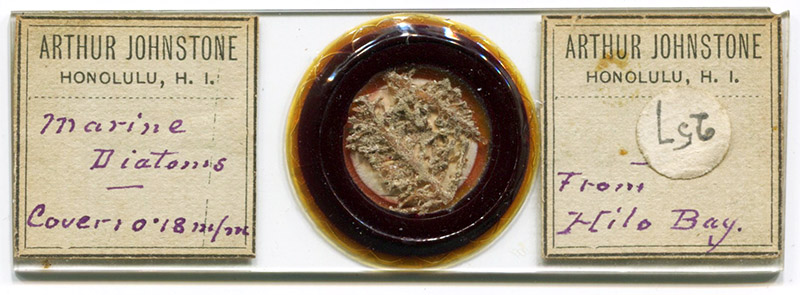Arthur Miller Johnstone, 1854-1924
by Brian Stevenson
last updated September, 2015
From the mid-1800s into the early 1900s, amateur societies of microscopy and other sciences flourished in many parts of the world. The islands of Hawaii (Sandwich Islands) were no exception, although acquiring equipment for the remote islands often posed challenges. The first report of a microscope in Hawaii was that of Dr. Charles Wetmore, who was recorded as exhibiting objects of curiosity in 1873. In February of 1875, a Dr. Harkness arrived in the islands, and was introduced to society as one who "not only has standing in his medical profession, but is also known as a man of science in the use of the microscope”. Harkness and his microscope generated such enthusiasm that The Natural History and Microscopic Society was founded in April, 1875. Members included Hawaii’s King Kalakaua and many other important members of society and business. The morning after the society formed, an order was sent to England for "a Binocular Microscope, one of Beck's make, of London, with objectives from 2 inch to 1/8 inch”, a dissecting microscope "with lenses of best quality, … a set of assorted mounted specimens in different branches [of the plant and animal kingdoms]", and textbooks, manuals, and sets of journals. Unfortunately, the dispatch ship was lost at sea, and the order had to be re-sent. Enthusiasm among this group of amateurs soon waned, however, and the society appears to have disbanded by 1878.
It was not until 1900, soon after Hawaii was annexed by the USA, that another society for microscopy was formed, the Honolulu Microscopic Society. This group included many practicing physicians and public health workers. The Corresponding Secretary was Arthur Johnstone, a journalist. Judging from the few known slides produced by Johnstone, he was a skillful slide-maker (Figures 1 and 2).

Figure 1.
A microscope slide by Arthur Johnstone, dry-mounted marine diatoms, in situ, from Hilo Bay, Hawaii. The specimen is attached to a circle of white paper, mounted for viewing by indirect light. Johnstone was a member of the Honolulu Microscopic Society from its beginning on March 10, 1900. The society appears to have dissipated by 1903, making it likely that this and other slides by Johnstone date from the first decade of the twentieth century.

Figure 2.
Magnified view of diatoms on the Johnstone slide shown above.
Arthur Johnstone was born during July, 1854, in Mount Pleasant, Iowa, USA, son of Alex and Margaret Johnstone. His father was a minister, and the family moved several times during Arthur’s childhood. The 1870 US census recorded the Johnstones as living in Santa Rosa, California. By 1879, they had moved to Oakland, California.
Arthur moved to Hawaii in early 1884. While a later census gave a date of immigration of 1885, Johnstone published a poem in The Hawaiian Monthly in May, 1884:
“If you should ever reach Oahu's shore,
I pray you journey thence to Diamond Head,
It lies beyond Waikiki, where the dead
Of long forgotten wars lie scattered o'er
The beach. The cliff uprises grim
before Moa-alii's den, where lurks, 'tis said,
The dread sea-god beneath the coral bed,
O'er which the breakers fall with sullen roar
And swoon within the peaceful bay beyond.
The mighty goddess Pele, she who drew
Destruction thro' the mountain's rocky seams,
And waved upon its crest her fiery wand,
Hath disappear'd; forlorn, thro' Time's review,
Her sentry stands, as one who waits and dreams.”
Johnstone’s move to the islands was probably to take work as a journalist. He was an editor of the Daily Honolulu Press when it began, in September, 1885. He served in similar positions through the remainder of his life. During the later 1800s, he was periodically arrested and sued for libel, results of his publishing letters to the editor that were not favorable to the King and other government officials.
Arthur married Julia Hope Afong in 1886. Julia was of mixed ancestry, her father being Chinese and her mother Hawaiian. The Johnstones had 8 children, 5 of whom survived to adulthood. The family was relatively well-off, with censuses recording that they employed domestic servants.
Robert Louis Stevenson made one of his trips to the Hawaiian islands in 1893. Johnstone, then the editor of the Pacific Commercial Advertiser, printed praises of a lecture presented by Stevenson at the Honolulu Thistle Club. Stevenson visited with Johnstone, and wrote a poem at Johnstone’s request called “The High Winds of Nuuanu”. In 1905, Johnstone published a book, Recollections of Robert Louis Stevenson in the Pacific.
Other than his slides and the description of Johnstone as Corresponding Secretary of the Honolulu Microscopic Society in 1900, I have not found any records of his involvement in microscopy. The Honolulu society appears to have dissolved by 1904. This information suggests that Arthur Johnstone’s microscope slides probably date from ca. 1900 until ca. 1904.
Arthur Johnstone died in Honolulu on August 21, 1924.
Resources
Bushnell, Oswald A. (1969) Much ado about little things: microscopes and microscopists, The Hawaiian Journal of History, Vol. 3, pages 101-110
Johnstone, Arthur (1884) Sonnet, The Hawaiian Monthly, Vol. 1, page 161
Johnstone, Arthur (1905) Recollections of Robert Louis Stevenson in the Pacific, Chatto & Windus, London
Johnstone, Arthur (1909) Charles Warren Stoddard, Hawaiian Almanac, Vol. 36, pages 141-148
Johnstone, Arthur (1912) The translation of Hawaii, Hawaiian Almanac, Vol. 39, pages 151-159
Stevenson, Robert L. (1973) Travels in Hawaii, edited by A. Grove Day, University of Hawaii Press
University of Hawai'i at Manoa, Hamilton Library on-line resources (accessed August, 2015) The Daily Honolulu Press, http://evols.library.manoa.hawaii.edu/handle/10524/24
USA census, birth, marriage, and death records, accessed through ancestry.com

